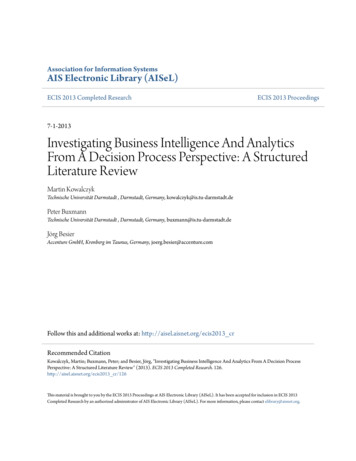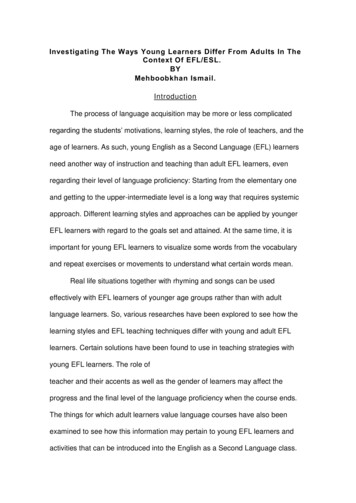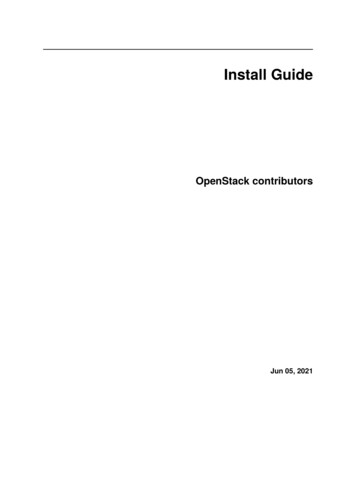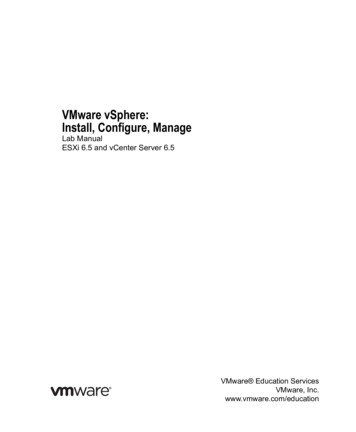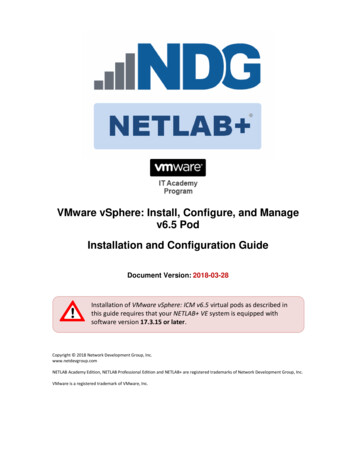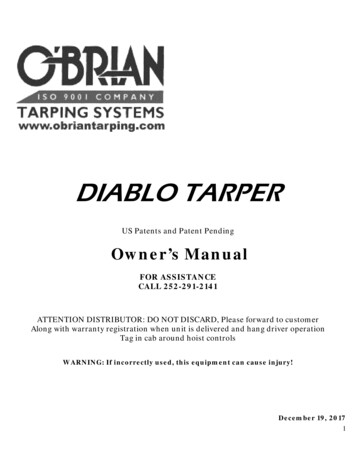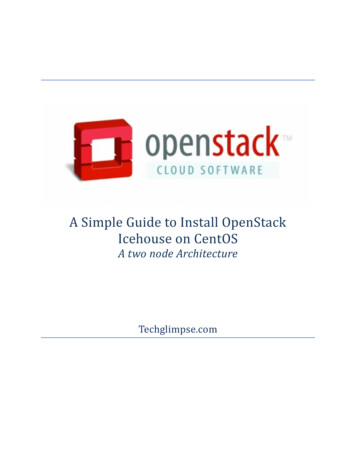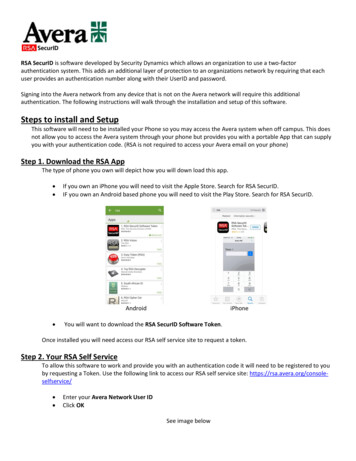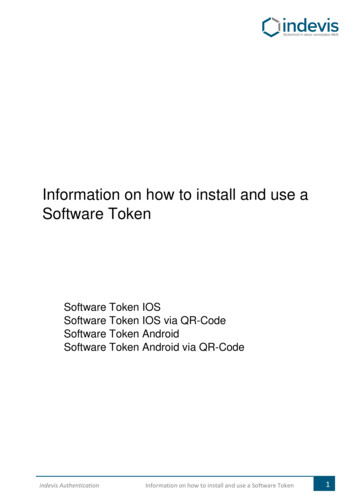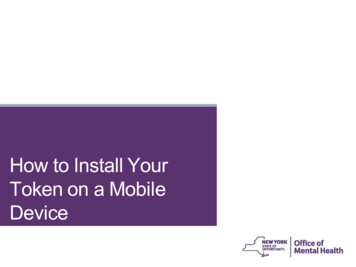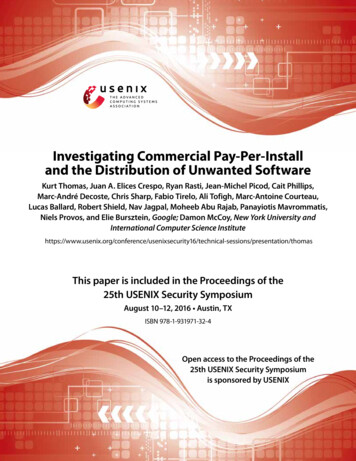
Transcription
Investigating Commercial Pay-Per-Installand the Distribution of Unwanted SoftwareKurt Thomas, Juan A. Elices Crespo, Ryan Rasti, Jean-Michel Picod, Cait Phillips,Marc-André Decoste, Chris Sharp, Fabio Tirelo, Ali Tofigh, Marc-Antoine Courteau,Lucas Ballard, Robert Shield, Nav Jagpal, Moheeb Abu Rajab, Panayiotis Mavrommatis,Niels Provos, and Elie Bursztein, Google; Damon McCoy, New York University andInternational Computer Science is paper is included in the Proceedings of the25th USENIX Security SymposiumAugust 10–12, 2016 Austin, TXISBN 978-1-931971-32-4Open access to the Proceedings of the25th USENIX Security Symposiumis sponsored by USENIX
Investigating Commercial Pay-Per-Install and theDistribution of Unwanted SoftwareKurt Thomas Juan A. Elices Crespo Ryan Rasti Jean-Michel Picod Cait PhillipsMarc-André Decoste Chris Sharp Fabio Tirelo Ali Tofigh Marc-Antoine CourteauLucas Ballard Robert Shield Nav Jagpal Moheeb Abu Rajab Panayiotis MavrommatisNiels ProvosGoogle†Elie BurszteinNew York University International Computer Science InstituteAbstractDespite the proliferation of unwanted software, theroot source of installs remains unclear. One potential explanation is commercial pay-per-install (PPI), a monetization scheme where software developers bundle severalthird-party applications as part of their installation process in return for a payout. We differentiate this fromblackmarket pay-per-install [4] as commercial PPI relies on a user consent dialogue to operate aboveboard.Download portals are a canonical example, where carelessly installing any of the top applications may leave asystem bloated with search toolbars, anti-virus free trials, and registry cleaners [16]. Unfortunately, this all toocommon user experience is the profit vehicle for a collection of private and publicly companies that commoditizesoftware bundling [15]. While earnings in this space arenebulous, one of the largest commercial PPI outfits reported 460 million in revenue in 2014 [31].In this work, we explore the ecosystem of commercialpay-per-install (PPI) and the role it plays in the proliferation of unwanted software. Commercial PPI enablescompanies to bundle their applications with more popular software in return for a fee, effectively commoditizing access to user devices. We develop an analysispipeline to track the business relationships underpinningfour of the largest commercial PPI networks and classify the software families bundled. In turn, we measuretheir impact on end users and enumerate the distributiontechniques involved. We find that unwanted ad injectors,browser settings hijackers, and “cleanup” utilities dominate the software families buying installs. Developersof these families pay 0.10– 1.50 per install—upfrontcosts that they recuperate by monetizing users withouttheir consent or by charging exorbitant subscription fees.Based on Google Safe Browsing telemetry, we estimatethat PPI networks drive over 60 million download attempts every week—nearly three times that of malware.While anti-virus and browsers have rolled out defensesto protect users from unwanted software, we find evidence that PPI networks actively interfere with or evadedetection. Our results illustrate the deceptive practices ofsome commercial PPI operators that persist today.1† Damon McCoyIn this work, we explore the ecosystem of commercialPPI and the role it plays in distributing the most notorious unwanted software families. The businesses profiting from PPI operate affiliate networks to streamline buying and selling installs. We identify a total of 15 PPI affiliate networks headquartered in Israel, Russia, and theUnited States. We select four of the largest to investigate,monitoring each over a year long period from January 8,2015–January 7, 2016 in order to track the software families paying for installs, their impact on end users, andthe deceptive distribution practices involved.IntroductionIn recent years, unwanted software has risen to theforefront of threats facing users. Prominent strains include ad injectors that laden a victim’s browser with advertisements, browser settings hijackers that sell searchtraffic, and user trackers that silently monitor a victim’sbrowsing behavior. Estimates of the incident rate ofunwanted software installs on desktop systems are justemerging: prior studies suggest that ad injection affectsas many as 5% of browsers [34] and that deceptive extensions escaping detection in the Chrome Web Store affectover 50 million users [17].We find that commercial PPI distributes roughly 160software families each week, 59% of which at least oneanti-virus engine on VirusTotal [36] flags as unwanted.For our study, we use this labeling to classify unwantedsoftware. The families with the longest PPI distribution campaigns include ad injectors, like Crossrider, andscareware that dupes victims into paying a subscriptionfee for resolving “dangerous” registry settings, a hair’slength shy of ransomware. We find that PPI networkssupport unwanted software as first-class partners: down-1USENIX Association25th USENIX Security Symposium 721
loaders will actively fingerprint a victim’s machine inorder to detect hostile anti-virus or virtualized environments, in turn dynamically selecting offers that go undetected. Software developers pay between 0.10–1.50per install for these services, where price is dictated bygeographic demand.Figure 1: Sample prompt bundling eight commercial pay-perinstall offers. Each offer is downloaded and automaticallyinstalled upon a user accepting the “Express Install” option.Users may have no knowledge of the behaviors of the bundledoffers.Via Safe Browsing telemetry, we measure the impactof commercial pay-per-install on end users across theglobe. On an average week, Safe Browsing generatesover 60 million warnings related to unwanted softwaredelivered via PPI—three times that of malware. Despitethese protections, estimates of unwanted software incident rates provided by the Chrome Cleanup Tool [5] indicate there are tens of millions of installs on user systems.Of the top 15 families installed, we find 14 distribute viacommercial PPI.sells access to compromised hosts, deceptive commercialPPI outfits rely on this prompt to nominally satisfy userconsent requirements. To simplify the process of buyingand selling installs, commercial PPI operates as an affiliate network. We outline this structure and enumerate themajor networks in operation during our study.Thousands of PPI affiliates drive these weekly downloads through a battery of distribution practices. We find54% of sites that link to PPI bundles host content relatedto freeware, videos, or software cracks. For the long tailof other sites where users are not expecting an installer,PPI networks provide affiliates with “promotional tools”such as butter bars that warn a user their Flash playeris out of date, in turn delivering a PPI bundle. In order to avoid detection by Safe Browsing, affiliates churnthrough domains every 7 hours or actively cloak againstSafe Browsing scans. Our findings illustrate the deceptive behaviors present in the commercial PPI ecosystemand the virulent impact it has on end users.2.1The pay-per-install affiliate structure consists of advertisers, publishers, and PPI affiliate networks. Figure 2presents the typical business role each plays.Advertiser: In the pay-per-install lingo, advertisers aresoftware owners that pay third-parties to distribute theirbinaries or extensions. Restrictions on what software advertisers can distribute falls entirely to the discretion ofPPI affiliate network operators and their ability (and willingness) to police abuse. As highlighted in Figure 2, advertisers include developers of unwanted software likeConduit, Wajam, or Shopperz that recuperate PPI installation fees by monetizing end users via ad injection,browser settings hijacking, or user tracking. Irrespectiveof the application’s behavior, PPI networks set a minimum bid price per install that advertisers only pay outupon a successful install. Advertisers may also restrictthe geographic regions they bid on.In summary, we frame our contributions as follows: We present the first investigation of commercialPPI’s internal operations and its relation to unwanted software. We estimate that commercial PPI drives over 60million download attempts every week. We find that 14 of the top 15 unwanted softwarefamilies distribute via commercial PPI.Publisher: Publishers (e.g., affiliates) are the creators ordistributors of popular software applications (irrespective of copyright ownership). An example would be awebsite hosting VLC player as shown in Figure 2. PPInetworks re-wrap a publisher’s application in a downloader that installs the original binary in addition to multiple advertiser binaries. This separation of monetizationfrom distribution allows publishers to focus solely ongarnering an audience and driving installs through anymeans. Consequently, advertisers may have no knowledge of the deceptive techniques that publishers employto obtain installs, nor what their binary is installed alongside. Upon a successful install, the publisher receives afraction of the advertiser’s bid. We differentiate this fromdirect distribution licenses such as Java’s agreement tobundle the Ask Toolbar [18], as there is no ambiguity be- We show that commercial PPI installers and distributors knowingly attempt to evade user protections.2PPI Affiliate StructureCommercial Pay-Per-InstallFor the purposes of this study, we define commercialpay-per-install (PPI) as the practice of software developers bundling several third-party applications in return fora fee. We present an example bundle in Figure 1, whereclicking on “accept” results in a user installing eight offers through a single radio dialogue. Some of these offersmay be unwanted software, where at least one anti-virusengine on VirusTotal marks the application as potentiallyunwanted, adware, spyware, or a generic category. Incontrast to blackmarket pay-per-install which illegally2722 25th USENIX Security SymposiumUSENIX Association
PPI Affiliate hPurebitsSolimbaSomotoFigure 2: Pay-Per-Install (PPI) business model. Advertiserspaying for installs supply their binaries to a PPI affiliate network ( ). The PPI network cultivates a set of publishers—affiliates with popular software applications seeking additionalmonetization ( ). The PPI network re-wraps the publisher’ssoftware with a customized downloader that the publisher thendistributes ( ). When end users launch this downloader, it installs the publisher’s software alongside multiple advertiser binaries ( ). The PPI network is paid by the advertisers and thepublisher receives a commission.First 01308/201310/2010 Table 1: List of 15 PPI affiliate networks, an estimate of whenthey first started operating, and whether they resell installs.fic where a victim is not primed to download a bundle. It is worth noting that these resellers do not operatetheir own downloader; they rely on sub-affiliate trackingprovided by larger PPI networks that effectively enablestwo-tiered affiliate distribution.2.2tween the advertiser and publisher around what packagesare co-bundled and the source of installs.Identifying PPI NetworksIn contrast to blackmarket pay-per-install [4], the affiliate networks driving commercial PPI are largely privatecompanies with venture capital backing such as InstallMonetizer and OpenCandy [8, 9]. Registering as a publisher with these PPI networks is simple: a prospectiveaffiliate submits her name, website, and an estimate ofthe number of daily installs she can deliver. Given thisporous registration process, underground forums containextensive discussions on dubious distribution techniquesand which PPI affiliate networks offer the best conversion rates and payouts. We tracked these conversationson blackhatworld.com and pay-per-install.com, enumerating over 50 commercial PPI affiliate programs that exclusively deal with Windows installs. While there arenetworks that target Mac and mobile installs, we focusour work on the relationship between commercial PPIand unwanted software families that disproportionatelyimpact Windows users as identified by previous studies [17, 34].PPI Affiliate Network: PPI affiliate networks serve asa bridge between the specialized roles of advertisers andpublishers. The PPI network manages all business relationships with advertisers, provides publishers with custom downloaders, and handles all payments to publishers for successful installs. When a publisher gains access to an end user’s system, the PPI network determineswhich offers to install. As we show in Section 3, this entails fingerprinting an end user’s system to determine anyrisk associated with anti-virus as well as to support geotargeted installations. Similarly, the PPI network dictatesthe level of user consent when it installs an advertiser’sbinary, where consent forms a spectrum between silentinstalls to opt-out dialogues. In some cases, advertiserscan customize the installation dialogue and thus play arole in user consent.Reselling: With multiple PPI affiliate networks in operation, various PPI operators will aggregate their publishers’ install traffic and resell it to larger PPI affiliatenetworks. These smaller PPI operators create value fortheir affiliates by providing promotional tools in the formof landing pages, banner ads, butter bars (e.g., “YourFlash player is out of date”), and generic installers formedia players and games—described later in Section 6.These tools simplify the process of monetizing web traf-2.3Acquiring PPI Downloader SamplesAs pa
tisers, publishers, and PPI affiliate networks. Figure 2 presents the typical business role each plays. dvertiser In the pay-per-install lingo, advertisers are software owners that pay third-parties to distribute their binaries or extensions. Restrictions on what software ad
